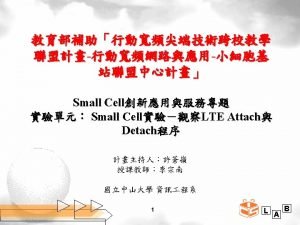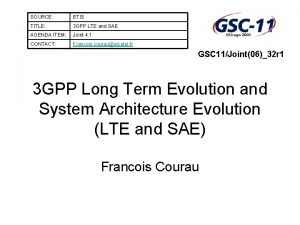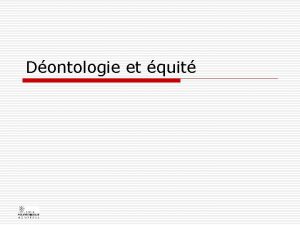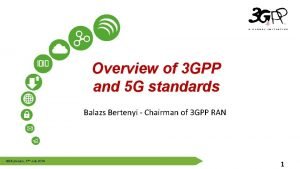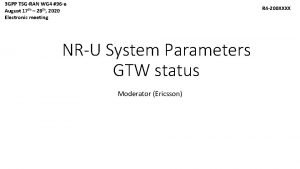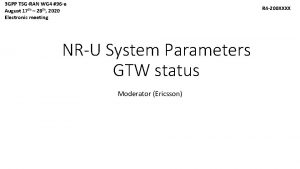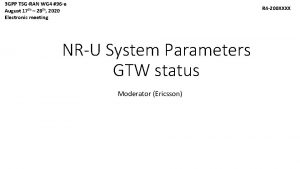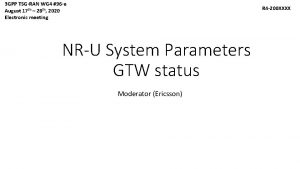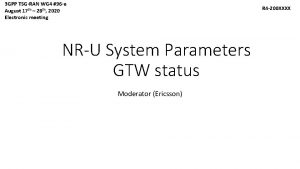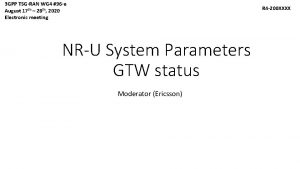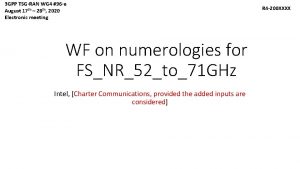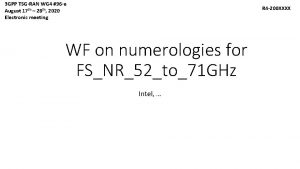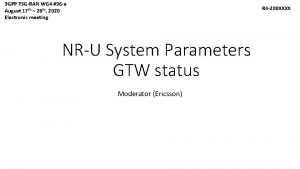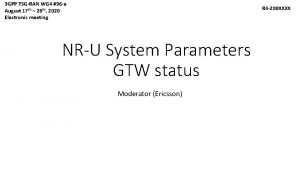3 GPP TSGRAN WG 4 96 e August






![Feature on Intra-band non-contiguous UL CA- Background 7 -3 a [Option 1: ] Intra-band Feature on Intra-band non-contiguous UL CA- Background 7 -3 a [Option 1: ] Intra-band](https://slidetodoc.com/presentation_image_h/206e00776b26de08de9a466f84463962/image-7.jpg)





- Slides: 12

3 GPP TSG-RAN WG 4 #96 -e August 17 th – 28 th, 2020 Electronic meeting R 4 -200 XXXX Rel-16 FR 1 intra-band UL CA GTW status Moderator (Huawei, Hi. Silicon)

Background l Two major topics related to UE feature under discussion: • Additional DC location reporting for intra-band UL CA • • In Rel-15, 3301(undetermined location) is allowed to report for intra-band UL CA, considering LO shift when CCs are activated/deactivated Goal: explicit DC location for intra-band UL CA can be reported to network • UE feature for intra-band uplink CA • • For intra-band contiguous uplink CA, WF(R 4 -2008466) agrees on the MPR requirement applicability on PA architecture, i. e. 1 PA architecture for BW class B, 1 PA and 2 PA architecture for BW class C For intra-band non-contiguous uplink CA, WF(R 4 -2005660) agrees on the relation among frequency separation, MIMO and PA architecture, i. e. Ø 1 PA/1 LO: instantaneous TX bandwidth: ~200 MHz Number of TX chain: 1 (2 TX to support UL MIMO) Ø 2 PA/2 LO: instantaneous TX bandwidth: >200 MHz can be supported (and below obviously) Number of TX chain: 2 (4 TX to support UL MIMO) • Goal: Complete UE feature for intra-band uplink CA

Additional DC location reporting Issue 1: Additional DC location reporting solution for intra-band UL CA. • Option 1: UE shall report the LO position after BWP activation command with same method as uplink. Tx. Direct. Current. List. • • Option 1 -1: g. NB is required to transmit RRCReconfiguration to the UE after each CC or BWP activation, and UE report DC location for the active BWPs by current RRC signalling. Option 1 -2: UE report the LO position after CC or BWP activation by new L 1/L 2 signalling. Note for discussion: 1 -1 RRC and DCI processing delay are not matched. Stringent requirement on g. NB side to provide RRCRconfig very frequently. 1 -2 Big change on spec. both RAN 1 and RAN 2 spec may be impacted considering BWP switching can be DCI triggered. Current DC location reporting by RRC signalling is changed. • Option 2: additional DC location is reported by RRC signalling per BWP pair for all possible combinations of configured BWPs on the UL CCs E. g. 4 BWPs are configured for CC 1, as BWP 1, 1 BWP 1, 2 BWP 1, 3 BWP 1, 4, and 4 BWPs are configured for CC 2, as BWP 2, 1 BWP 2, 2 BWP 2, 3 BWP 2, 4 UE additionally report the DC location for each possible BWP pair which can be activated simultaneously for intra-band UL CA: DC 1: BWP 1, 1+ BWP 2, 1 DC 2: BWP 1, 1+ BWP 2, 2 DC 3: BWP 1, 1+ BWP 2, 3 … DC 12: BWP 1, 4+ BWP 2, 4 Note for discussion: For 2 UL CCs, 16 additional locations need to be reported, more bit number is required. It does not change the current DC location reporting mechanism by RRC signalling. Have no impact to RAN 1 spec. • Agreements: • TBD

Additional DC location reporting-con’d Issue 2: UE capability for Additional DC location reporting for intra-band UL CA l l Option 1: Introduce new UE capability to indicate whether UE support Additional DC location reporting solution for intra-band UL CA Option 2: no need to introduce UE capability • Agreements: • TBD

Feature on Intra-band contiguous UL CA Issue 1: whether the below feature item for intra-band contiguous UL CA is added to RAN 4 feature list? 7 -3 b NR CA class List for Intraband contiguous CA 1. Indicate the contiguous CA bandwidth class that Intra-band UL UE can support 2. On the condition that component 1 is indicated, CA band combination indicate the PA architecture, i. e, 1 PA or 2 PA 3. On the condition that component 1 and component 2 are indicated, indicate the MIMO layer number for each UL CC separately contiguous Yes N/A [Network cannot schedule intra-band contiguous UL CA transmission properly] FFS No need FR 1 N/A [for each contiguous CA bandwidth class, if 2 PA architecture is indicated, MIMO is not supported for both UL CCs by default] [Optional with capability signalling, ] NOTE 1: there is dependency for the three components as given above l Option 1: Yes l Option 2: No • Components 1/2/3 are the capability based on the existing signaling. • Bandwidth class, PA architecture and MIMO layer are relevant for intra-band contiguous UL CA, the relation is clarified in the feature list • Agreements: • TBD

Feature on Intra-band contiguous UL CA-con’d Issue 2: clarification on capability for intra-band contiguous CA Proposals o Option 1: For bandwidth class B, only 1 PA architecture is valid. For bandwidth class C, if 2 PA architecture is indicated by UE, UL MIMO is not supported by default, but additional signalling is provisioned for UL MIMO support o Option 2: No clarification in RAN 2 spec • Agreements: • TBD
![Feature on Intraband noncontiguous UL CA Background 7 3 a Option 1 Intraband Feature on Intra-band non-contiguous UL CA- Background 7 -3 a [Option 1: ] Intra-band](https://slidetodoc.com/presentation_image_h/206e00776b26de08de9a466f84463962/image-7.jpg)
Feature on Intra-band non-contiguous UL CA- Background 7 -3 a [Option 1: ] Intra-band Yes UL non. List for intra. Indicate the maximum UL frequency separation that UE can support contiguous band nonfor each UL transmission chain for intra-band non-contiguous CA in CA band contiguous CA] the following format combination [NR CA class {{UL separation class for UL FR chain 1; UL separation class for UL FR chain 2} Note 1: maximum UL frequency separation means maximum frequency span between lower edge of lowest component carrier and upper edge of highest component carrier that UE can support in uplink [Option 2: ] Indicate the maximum UL frequency separation that UE can support which includes the gap between two non-contiguous CCs for intraband non-contiguous CA Note: maximum UL frequency separation means maximum frequency span between lower edge of lowest component carrier and upper edge of highest component carrier that UE can support in uplink N/A [Network cannot schedule intra-band noncontiguous UL CA transmission properly] For Option No need 1 in component item: Type 3 (per BC) For Option 2 in component item: Type 4 (per FS) For Option 3 in component item, Type 3 (per-BC) for component 1 and 2, Type 5 (per FSPC) for component 3 FR 1 only N/A Based on the agreed WF R 42005660 both 1 PA and 2 PA architecture for intra-band noncontiguous UL CA will be considered for UE capability, and MIMO supporting with 4 TX for 2 PA UL NC CA should not be excluded. The maximum UL CC number for intra-band UL CA is 2 in Rel-16. NC CA bandwidth class candidate values: • Class 1: NC CA separation class≤ 100 MHz • Class 2: 100< NC CA separation class≤ 200 MHz • Class 3: NC CA separation class > 200 MHz and <600 MHz [Option 3: three components] 1. Indicate the NC CA bandwidth class that UE can support, which includes gap between two non-contiguous CCs for intra -band non-contiguous CA 2. On the condition that component 1 is indicated, indicate the PA architecture, i. e, 1 PA or 2 PA 3. On the condition that component 1 and component 2 are indicated, indicate the MIMO layer number for each UL CC separately NOTE: there is dependency for the three components as given above [Optional with capability signalling, ]

Feature on Intra-band non-contiguous UL CA Issue 1: implication of the new introduced NC CA bandwidth class Option 1: A parameter for the specific NC CA configuration which is similar as bandwidth class for contiguous CA, NC CA bandwidth class includes both the bandwidths of UL CCs and gap between CCs l Option 2: the maximum frequency separation UE can support, which is similar as separation class defined for FR 2 l • Agreements: • TBD One parameter of the specific NC CA configuration • • • For each NC CA configuration, introduce a new parameter on the bandwidth class which includes bandwidths of UL CCs and gap between CCs Assume UE physically implements 2 PAs on Band n 77 For NC CA configuration at Band n 77(2 A), i. e. 2 CC, aggregated bandwidth=150 MHz For NC CA bandwidth class= 100 MHz-200 MHz, UE can report PA architecture is 1 PA, MIMO layer=2 • For NC CA bandwidth class= 200 MHz-600 MHz, UE can report PA architecture is 2 PA, MIMO layer=1 It is clear for UE to report PA architecture and MIMO layer for different NC CA bandwidth classes, where different bandwidth classes are attributes to the same aggregated bandwidth • Maximum frequency separation UE can support • • • Assume UE physically implements 2 PAs on Band n 77 The maximum frequency separation for 1 PA is 200 MHz, for 2 PA is ‘no limitation’ or ‘ 600 MHz’(maximum value) For NC CA configuration at Band n 77(2 A), i. e. 2 CC, aggregated bandwidth=200 MHz: If UE reports the max frequency separation is 200 MHz, PA architecture is 1 PA, then it can support MIMO layer=2 • If UE reports the max frequency separation is 600 MHz, PA architecture is 2 PA, then it can support MIMO layer=1 Since MIMO and PA architecture are relevant, it is not clear to just report one maximum frequency separation, because UE do not know PA architecture before NC CA is configured to the UE •

Feature on Intra-band non-contiguous UL CA-con’d Issue 2: NC CA bandwidth class definition if introduced • Option 1: Class 1: 10 -100 MHz Class 2: 100 -200 MHz Class 3: 200 -600 MHz currently only applicable to n 77 Class 4: for future use • Option 2: Class 1: 10 -100 MHz Class 2: 100 -200 MHz Class 3: >200 MHz • Agreements: • TBD

Feature on Intra-band non-contiguous UL CA-con’d Issue 3: MIMO layer, NC CA bandwidth class and PA architecture relation for intra-band non-contiguous CA feature • Option 1: Clarify on the relation among MIMO layer, NC CA bandwidth class and PA architecture in the feature list 1. Indicate the NC CA bandwidth class that UE can support, which includes gap between two non-contiguous CCs for intra-band noncontiguous CA 2. On the condition that component 1 is indicated, indicate the PA architecture, i. e, 1 PA or 2 PA 3. On the condition that component 1 and component 2 are indicated, indicate the MIMO layer number for each UL CC separately NOTE: there is dependency for the three components as given above • Option 2: No need to clarify on the relation • Agreements: • TBD

Feature on Intra-band non-contiguous UL CA-con’d Issue 4: clarification on capability for intra-band non-contiguous CA • Option 1: if UE indicate 2 PA architecture for intra-band UL NC CA configuration, then UL MIMO is not supported by default, but additional signalling is provisioned for UL MIMO support • Option 2: No limitation • Agreements: • TBD

Feature on Intra-band non-contiguous UL CA-con’d Issue 5: UE capability on In-gap ACLR and SEM/SE: indicate the in-gap ACLR and/or SEM/SE need to be relaxed for intra-band non-contiguous UL CA l Option 1: Introduce UE capability on In-gap ACLR and SEM/SE l Option 2: No need to introduce Note for discussion: it is already agreed in previous RAN 4 meeting WF: For 1 PA/1 LO architecture, exception should be allowed while the leakage and image falling on a frequency belonging to another licensee assuming synchronization across licensees, or if LO leakage lands on licensee's own spectrum holding. • Agreements: • TBD



